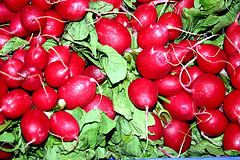Radishes
| Infobox on Radishes | |
|---|---|
| Example of Radishes |  |
| Freshness facts | |
| Optimum carrying temperature | 0°C |
| Highest freezing point | -0,7°C |
| Acceptable product temp. at loading into containers | Max. 2°C above carrying temperature |
| Optimum humidity | 90% to 95% |
| Ventilation setting for containers | 0 m³/hr |
| Storage life | 2-3 weeks |
| Climacteric / non-climacteric | Non-climacteric |
| Ethylene production | Low |
| Ethylene sensitivity | None |
| Modified / controlled atmosphere | 1%-2% O2; 2%-3% CO2 |
| Potential benefits | Slight |
| Availability | |
| On demand | |
Radishes
Contents
Harvesting and Handling
Radish is a diversely formed root vegetable and has many uses worldwide. Red and icicle radish are most common but Asian "daikon" types are increasing in popularity outside of countries such as Korea, Japan, Taiwan and China.
A minimum size standard for common red radish is 1,5 cm equatorial diameter. Current crop management practices stress rapid growth to ensure a mild flavour and crisp texture. Fertilization and irrigation management, or environmental conditions that slow growth may result in a woody texture and high pungency. Over-mature radish tends to be pithy (vacuolated) or spongy in texture and may develop harsh flavours, for most palates.
Roots of Bunched or Topped Common Red Radish should, ideally, be of uniform and similar shape for the variety, well formed, smooth, firm but of tender texture, and free of growth or harvest damage, and free of decay, disease or insects. Bunched radish tops should be fresh in appearance, turgid, and free of freeze injury or other serious injury, seed stalk, yellowing or other discoloration, disease, decay, or insects. Currently radishes are cut or diced in packaged salad mixes, and for foodservice, particularly for incorporation into salad bars.
Cooling and Storage
Rapid cooling to 0°C is essential to achieve the full storage potential of both bunched and topped roots. Radish is often top-iced to maintain temperature and contribute moisture for retaining a crisp texture. Under these conditions common red radish may be expected to maintain acceptable quality for 1 to 2 weeks with tops and 3 to 4 weeks if topped. Daikon-type radish may last from 3 to 4 months at these same conditions.
Radishes are not chilling sensitive; store as cold as possible without freezing. Freezing injury can cause softening and shrivelling, and leakage of pigment for red radishes.
Controlled atmosphere considerations
CA conditions slightly extends storage-life
Storage disorders
Black spot, Bacterial soft rot, Downy mildew, Black root rot











